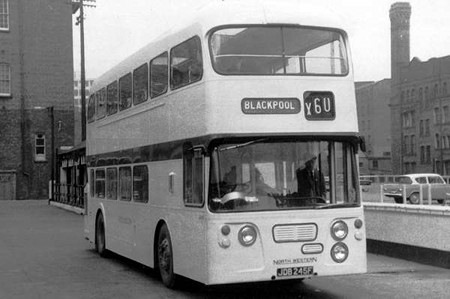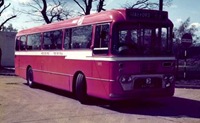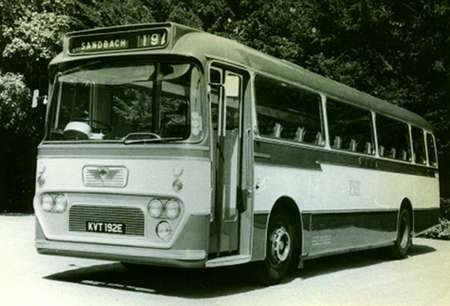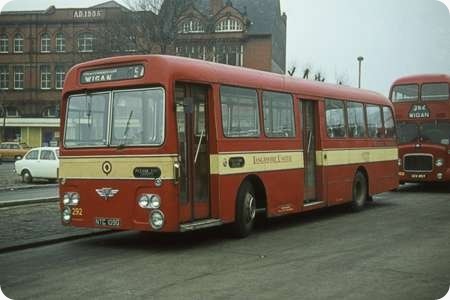
Copyright Ian Lynas
North Western Road Car Co
1967
Daimler Fleetline CRG6LX
Alexander H44/31F
Here we have one of a batch of North Western Daimler Fleetlines with an Alexander body. According to the PSV Circle Publication PX3 Post-War Second-Hand British Buses in North America mentions that two of the batch 245 and 247, JDB 245E and JDB 247E became 213 and 215 at City of Oxford Motor Services. They then went to Ensign a dealer in Grays, Essex. 245 in October 1979 and 247 in February, the following year both being exported to World Square, Kailua, Oahu, Hawaii in April 1980.
There is a couple of problems with this. First they were F registered (see photo of 245 at Lower Moseley St Bus Station in 1970, about a month before I went to Australia), this of course is most likely a simple typo
The second problem is that Kailua is not on Oahu (the main island), Kailua is on "the big island", Hawaii in the town of Kona and on a visit to World Square in 2004, there was no sign of either of the two North Western Fleetlines, although one shopkeeper did remember them.
Does anybody have photos of the Fleetlines at World Square on the big island of Hawaii.
Photograph and Copy contributed by Ian Lynas
03/03/13 – 14:19
I’d imagine that, apart from age, the difficulty of obtaining spares for a defunct manufacturer’s product – as is the case for both engine and chassis – at such a distance would have removed the Fleetlines from service well before 2004. Whilst a Cummins may well have been a suitable alternative engine, new or used, it would most likely have been more cost effective to buy other, newer, vehicles.
"Mutton dressed as lamb" or perhaps "All dressed up but nothing to show" springs to mind seeing the photo. 245-248 were painted in coach livery particularly for the X60 in 1970 though they did appear on other services.
Paint doesn’t make a coach and patrons still had to sit on bus seats and the drive train was not re-geared so they were not as fast as the Mk3 Lolines with the 5 speed gear box which had regularly appeared on the X60 without the benefit of masquerading as a coach.
Still anything was better than making the trip on a Willowbrook bodied K5G which regularly appeared as duplicates on the service up until 1964. Now one of those in coach livery would have been something else!
Phil Blinkhorn
04/03/13 – 08:02
Phil makes some interesting comments about North Western’s "pseudo White Ladies" which prompts me to ask:
I know the Ribble, Standerwick and Scout "Gay Hostesses" had upgraded seating, but did they and the White Ladies have alterations to the drive train?
Did the White Ladies (the old Titans or the Atlanteans) have upgraded seating?
Sadly, I don’t have interior views of the preserved PD2 or Atlantean White Ladies, only exteriors.
On from that, I do accept that the ride from Manchester to Blackpool on any vehicle with bus seating will not have been wonderfully comfortable, but it can’t be as bad as an Ambleside Depot HR44 Olympic which turned up at Morecambe Bus Station on the London service one summer Saturday morning in about 1965. No, folks, it wasn’t the luggage hauler!
Pete Davies
04/03/13 – 09:03
As a soft Yorkshireman, and a coach man, weaned on Sheffield United Tours and S J O C coaches, I always went for the idea that even Sheffield – Manchester ought to be run by coaches. I was never impressed by the North Western/Ribble – let alone Yorkshire "J" services – running service buses (often "disguised" as coaches). To see X2 Nottingham – Blackpool with a bus Leopard would not impress me. Bus Leopards, REs or Nationals didn’t impress me when they turned up on the X67 Mansfield – Chesterfield – Manchester workings.
David Oldfield
04/03/13 – 15:08
The original White Ladies bodied by Burlingham and East Lancs had moquette trimmed higher backed than bus seats coach seats, but suffered from the lowbridge layout in so much as the upper deck had four seats across.
The Atlantean White Ladies for regional express services, which were more cream than their ancestors, had coach seats with head rests and individual seat frames. At one period in the late 1960s 1272 used to be an almost every weekday sighting for me as it ploughed a constant furrow on the X43 between Skipton and Manchester. The Atlanteans with 59 seats had a fair turn of speed so overtaking them on the de-restricted sections of the A56 was often a matter of fine judgement
Phil Blinkhorn
04/03/13 – 15:13
David, as a Lancastrian both by birth and by residence, I feel honour bound to point out that Yorkshire companies were equally fond of using standard service buses on completely inappropriate express workings. Examples which spring readily to mind are West Yorkshire (Bristol L type saloons on Leeds to Liverpool timings as late as 1964!), Yorkshire Woollen (various ageing service buses also on the X97/99 whenever better vehicles were needed for private-hire/excursion duties), Yorkshire Traction (Saro bodied Tiger Cubs on their share of the Blackpool services)….need I go on?
As an enthusiast I used to be quite excited to get one of NWRCC’s Bristol K5Gs on an X97 from Sale to Liverpool (this happened to me twice in 1964/65 – their final year in service – and the chassis on these vehicles were pre-war). I must confess though that the other passengers looked less excited.
I agree with you completely about the use of saloons on the X1/X2/X60 interchange. This was little short of a disgrace and all three operators (Ribble/NWRCC/Trent) were guilty of it. I think the ultimate prize for such inappropriate scheduling (apart from the HR44 already mentioned, although from personal experience I suspect that this gave its passengers to something classier at Preston)should go to Boyer – the Leicestershire independent absorbed by Midland Red. They regularly used their pair of Sentinel STC6/44 service buses on their express timings to Blackpool. As much as I love Sentinels this was a step too far!
Neville Mercer
04/03/13 – 17:41
Neville. As I’ve said before, I can be guilty of shorthand language which can be a little unclear. My reference to the Yorkshire J services was my acknowledgement that we were equally guilty on our side. Sorry if I was clear as mud. I only lived in Sale from 1976 – 1981 so missed K5Gs (thank goodness). As one of Bristol’s biggest fans I’m afraid – even in the flat-lands of South Manchester and the Cheshire Plain – only a 6B or 6G would do for me…..
David Oldfield
04/03/13 – 17:42
….And there can be few to rival your knowledge of Sentinels, Neville. Your comprehensive book, with co-author John Howie, on this marque is a masterpiece of research and writing.
Roger Cox
05/03/13 – 06:49
…..or indeed anything Neville turns his hand to…..
David Oldfield
05/03/13 – 06:49
Thank you, Phil. I hope Neville’s correct about transferring passengers from the HR44 at Preston. From what I recall of the Inspector’s answer to a customer, it didn’t seem likely on this occasion.
Pete Davies
05/03/13 – 06:50
Of course, everyone is right about inappropriate vehicles on long distance express services – but actually there were a lot of long routes right across the country that were routinely operated by normal seated buses. At the end of the day it is how long you are sitting in a low-backed bus seat, rather than how far you have travelled, that determines how acceptable it is. I think of the Ribble 555 Keswick – Lancaster service at nearly 3 hours; Western National’s old 18 when it ran all the way from Penzance to St Austell – also 3 hours. I have mentioned before how Lincolnshire often operated the route 3 Lincoln – Cleethorpes (2 hours) with Bristol SC4LK’s. I suspect some of London Transport’s longer central area services also took a couple of hours, though I was never very familiar with them. Obviously, on some of these routes, through passengers would be in the minority – but they were by no means a rarity.
Stephen Ford
05/03/13 – 12:24
I recall that the X60 and other Blackpool services used other operators’ buses on hire in the summer season. In the 1960s, Todmorden JOC used a coach-seated Leopard on hire to Ribble, but if one was not available, the bus-seated version would be used. I’m not sure if TJOC lowbridge Leylands were used previously; if so, they were not that different mechanically from the Ribble "White Ladies" used on the X4 Manchester – Blackpool via Rochdale and Todmorden, which took 3½ hours, although it’s unlikely that many did the full trip.
Geoff Kerr
05/03/13 – 13:48
My thanks to Roger and David for the embarrassing praise! I quite agree with Stephen about the longer stage carriage routes – another one which springs to mind was the 122 from Gravesend to Brighton. Not sure how long it actually took but it seemed endless in a fully loaded ‘decker. I still think that the X2/X60 interchange takes the proverbial biscuit – this clocked in at more than six hours which was a ridiculous amount of time to spend aboard a service bus. Fortunately (as far as I know!) there was no similar scheduling of saloons on the X7/X2/X60 double interchange from Great Yarmouth to Blackpool. But I could be wrong – especially in the case of joint operator Ribble who seemed unable to tell the difference between a coach and a bus. Although I never saw the aforementioned HR44 on the London services I did record a bus-seated PSU3 Leopard at Victoria Coach Station in 1966. OK, it was brand new at the time, but I suspect that the "new bus smell" did little to mollify the passengers who required buttock amputation after the trip. On the other hand the Gay Hostess Atlanteans were not as good as they looked from a passenger comfort viewpoint. Toilet smells tended to permeate the lower deck while those upstairs (even if, like myself, not prone to travel sickness) soon became weary of the pitching and yawing on any road less glamorous (?) than a fully-fledged motorway.
You know I love Yorkshire, David – it’s my second favourite county….
Neville Mercer
05/03/13 – 14:39
I must admit that the thought of travelling on the upper deck of a Gay Hostess Atlantean at 60 mph, even on the relatively empty M1 of the 1960s, fills me with trepidation even now.
I well remember driving at just under 60 mph in my upright Ford Pop (top speed 65, down hill with a following wind) and being thrown off course with one passing me at speed south of Newport Pagnell. When the next one in a convoy of three appeared in my mirror I slowed down!!
Phil Blinkhorn
06/03/13 – 06:48
I don’t have any information as to running times Etc, but one of the longest routes to use services buses must have been the Western SMT route between Glasgow and Stranraer. It more or less followed the A77, which was, and still is for the most part single carriageway, and by the time it went into and out of every village along the way, it must have been around the 90 mile mark from end to end. I would assume the crews would have been on a part way changeover basis, with three or more depots involved. Can anyone give any details?
Ronnie Hoye
06/03/13 – 06:48
Am I not right in thinking that one of Standerwick’s ‘best’ came to grief on its side on the motorway on one occasion?
Chris Hebbron
06/03/13 – 06:50
My worst journey was returning from a holiday in Leven (Fife) to Glasgow in an Alexander owned, Alexander rebodied with a semi-utility lowbridge TD4 body.
The temperature was in the 80s and the bus was packed, with many unhappy young children and parents in need of another holiday!
Jim Hepburn
07/03/13 – 06:42
The mention of operators hiring in vehicles for express services reminded me that many years ago in High Street Heckmondwike I saw one of Bradford Corporations AEC Reliance on hire to Hebble returning from Blackpool.
Philip Carlton
07/03/13 – 10:44
I can help you there, Ronnie. as, in my RAF National Service days, I travelled on it (to & from Cairnryan) several times in mid-1958 to spend weekends in Glasgow. The total distance is about 90 miles. The journey took four hours, with a stop for crew-change, re-fuelling and passenger ‘toileting’ inside Ayr Depot, some fifty miles into the journey. From Stranraer to Ayr, it was very scenic. It was a two-hourly service and Western SMT used new’ish tin-fronted Leyland PD2’s with lowbridge Northern Counties bodies on the route. It was pretty well patronised, but few passengers rode for more than about 25% of the journey. The other long’ish routes I used to do was Southdown 31 from Southsea to Brighton (52) and the A&D (24?) from Petersfield to Guildford (30 miles) and Red & White 73 from Gloucester to Newport (48), originally to Cardiff, later only to Chepstow, now just to Lydney!
Chris Hebbron
07/03/13 – 10:48
In the longest journeys class would be the joint United / SMT routes from Newcastle to Glasgow and Edinburgh; these were stage carriage most of the way, and indeed the only bus service in many parts. I believe they would normally be either service buses or at best ‘dual-purpose’. The 15 from Newcastle to Glasgow took 7 1/2 hours (or 8 including the summer only extension to Whitley Bay)although this did include a comfort break and crew change at Galashiels.
David Todd
07/03/13 – 17:04
Not sure about the Atlanteans but in 1974 one of Standerwick’s Bristol VRL coaches overturned on the M1 near Luton causing 3 deaths and some serious injuries. Incidentally the only time I used a Standerwick Atlantean on the Colne to London service it broke down on the M1. Numerous other trips with Leopards passed without incident.
Paragon
07/03/13 – 17:30
I’d agree with PARAGON on this. I’ve never heard of one of the Atlanteans falling over, but I do recall one of the VRLs doing that trick. Am I right in thinking they moved on shortly afterwards?
Pete Davies
07/03/13 – 17:59
The Standerwick VRL accident arose when the driver attempted to avoid a lamp standard that was leaning across the carriageway resulting from a crash by an articulated lorry just in front of the coach. The VRL and its passengers – sadly 3 killed and 30 injured – were essentially the victims of circumstances outside their control.
Roger Cox
08/03/13 – 07:15
I think it is correct that one of the Standerwick Gay Hostess (i.e. Atlantean) coaches finished on its side somewhere down the M1. This would be the late 1960s, it is my understanding that the driver involved was Burnley-based, and that he was still at that depot in 1970/71 when I was on Laycock’s.
David Call
30/03/13 – 14:09
The Standerwick decker we immediately think of allegedly dropped into the (in those days) soft central strip which led to a few control problems! if it was the same one the story was that he’d taken evasive action to avoid an artic which had, or was in the process of, jackknifing.
In these days of tachos and pedestrian progress imposed by Brussels it is difficult to relate to the speed a Standerwick decker "flew" at, we were scheduled to average 70 on a "Z" you saw a white dot in offside mirror which grew and grew, they then blasted past like you were standing still!
Allegedly, (and no reason to doubt it) they used a full set of brakes in a fortnight, as far as I know they didn’t have retarders, didn’t they come later on in life?
The economics of decker coaches at the time was against them as 51 seaters were just coming in and they could only carry sixty, there were also fun and games in London as they couldn’t (but at least one tried!!) get through Sammy’s
Pete Bradshaw
26/05/15 – 06:42
Regarding North Western’s "pretend" White Ladies. I can’t remember now. Were they delivered in fleet livery (mainly red)? I thought so up to now.
Bob Bracegirdle
26/05/15 – 11:02
245-248 were delivered in fleet livery and were painted in 1970 for the Blackpool express service.
Stephen Howarth
 Vehicle reminder shot for this posting
Vehicle reminder shot for this posting
11/02/20 – 07:27

Here is a picture of 245 taken in Manchester in June 1970. The fixed glazing apart from the openings on the last window on each deck must have made for dubious ventilation characteristics.
Roger Cox
12/02/20 – 16:42
With the exception of the Bedford VALs, all North Western deliveries, both single and double deckers, from 1964 to 1971 had forced air ventilation of one form or another. The system certainly worked when new and presumably continued to provide satisfactory ventilation as only 2 Fleetlines were delivered without the system. An experimental Compas heating and ventilation system was installed on 188 and 189, delivered in 1965, but this was not used for the 1967 deliveries which reverted to the system as installed on previous vehicles and 245.
Phil Blinkhorn
 Vehicle reminder shot for this posting
Vehicle reminder shot for this posting






